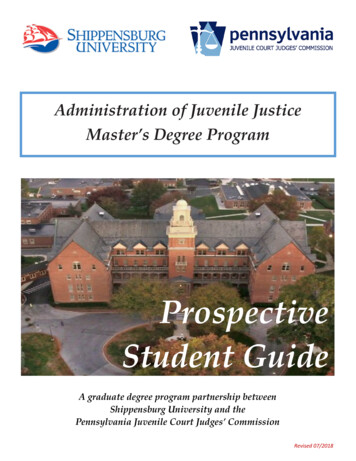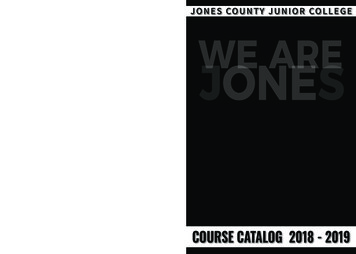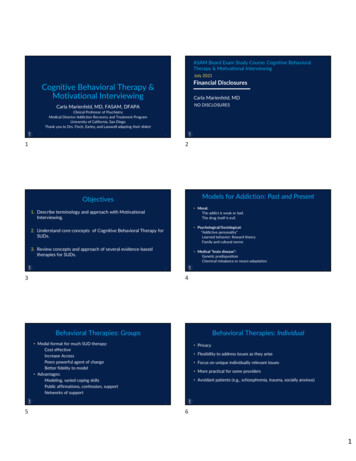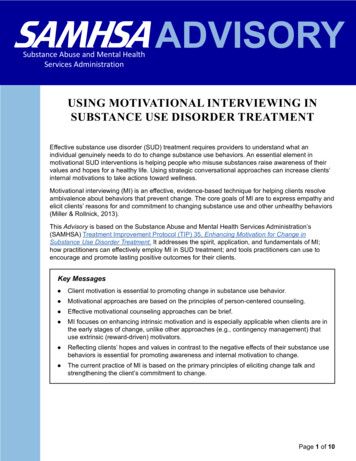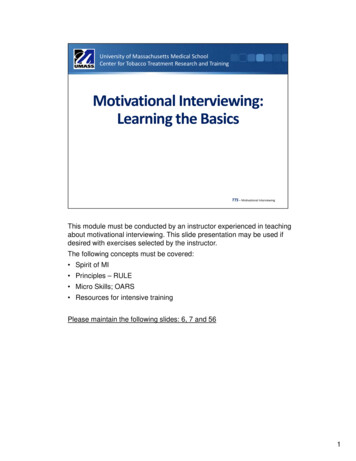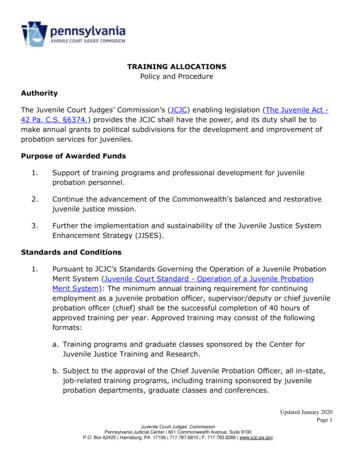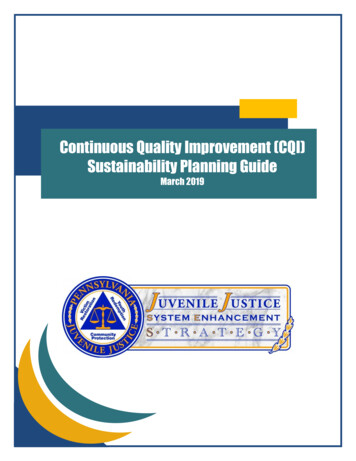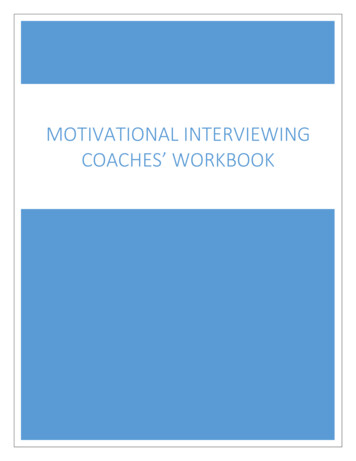
Transcription
MOTIVATIONAL INTERVIEWINGCOACHES’ WORKBOOK
Purpose and Use of the Motivational Interviewing WorkbookPurpose: In 2015, the “Motivational Interviewing Implementation and PracticeManual” became available to all juvenile probation departments as a resource ofsteps, materials, strategies, and protocols to guide departments in the trainingand implementation of motivational interviewing practices. The Manualhighlights the awareness that the investment into this Stage 2 activity of theJuvenile Justice System Enhancement Strategy (JJSES) is intentional andpurposeful within an average two-year process. Given differences in pace andtiming, counties across the Commonwealth are at various stages of MIimplementation. Nonetheless, what has been found to be critical is theidentification, support, and continuous training of motivational interviewingcoaches. This workbook is intended to offer coaches assistance in this vital roleand provide tools for staff training.Use: Probation Officer proficiency in the use of MI requires ongoing boosters,small group trainings, reinforcement of MI skills, and the providing offeedback. The role of an MI coach is to be an ambassador in executing theselearning events. This will not only enhance the proficiency and confidence ofthe MI coach, but it will also move the department from proficiency intoimplementation and long term sustainability. The time that an MI coach willspend in this role will vary based on the individual needs of their department.At a minimum, bi-annual half-day booster trainings are recommended.Booster training topics should include all of the Eight Stages of MotivationalInterviewing:1. Spirit of MI2. OARS
3. Recognizing Change Talk4. Eliciting and Strengthening Change Talk5. Resistance6. Developing a Change Plan7. Consolidating Client Commitment8. Switching Between MI and Other MethodsAn important theoretical contribution to motivational interviewing is Prochaskaand DiClemente’s “Stages of Change” model (DiClemente & Velasquez, 2002).Understanding the Stages of Change model and accurately assessing whichstage the youth is at is critical. Failing to focus on the tasks of the appropriatestage can lead to disengagement, predictable failures, and violations. It istherefore recommended that Stages of Change be added as a training topic forenhancing motivational interviewing skills.Additionally, MI coaches can assist in skill practice, engage in policy andprocedure discussions, individualize training needs (especially for new hires),promote stakeholder engagement, and become a regional resource forneighboring counties.The Workbook is organized by the eight stages of learning motivationalinterviewing and the Stages of Change model. Various modalities will beprovided to accommodate learning styles, formats, and training durations.Some activities will overlap into other chapters and JJSES related activities.Where overlap exists, cross references will be noted at the bottom of thematerial.
CONTENTSChapter 1Spirit of Motivational InterviewingChapter 2Core MI Skills: OARSChapter 3Recognizing Change TalkChapter 4Eliciting and Strengthening Change TalkChapter 5Rolling with ResistanceChapter 6Developing a Change PlanChapter 7Consolidating Client CommitmentChapter 8Switching Between MI and Other MethodsChapter 9Stages of Change
CHAPTER 1THE SPIRIT OF MOTIVATIONAL INTERVIEWING
Handout 1.1: PACEHandout 1.2: SPIRIT OF MI CHECKLISTIntroduction & Directions: These handouts provide easy reference to thecomponents of the spirit of motivational interviewing along with a checklistreminder. The quote by Stanley Kubrick, a well-known film director, offersanother way of understanding the importance of the spirit of MI. The handoutmay also be used as an email reminder/attachment to keep MI alive betweenbooster sessions.Purpose: Provides a simple definition of the spirit of MI, a visual aid, a checklist,and a quote to capture its importance using little instruction or interaction.
HANDOUT 1.1The Spirit of Motivational InterviewingDefinition: MI is more than the use of a set of technical interventions. It is alsorelational and characterized by a way of being with the client. This relationaldimension is referred to as the “spirit” of MI which has four main components.Mindful attention to the spirit of MI builds rapport and professional alliance.PACE PARTNERSHIP - Collaboration means working in partnership with theclient. We don’t MI people; rather, we use MI with people. AUTONOMY/ACCEPTANCE - In general, if people think that they aremaking changes for their own reasons, they are more likely to maintainnew behaviors. The opposite of autonomy support is to make people dothings, to coerce and control. COMPASSION - To actively promote the other’s welfare, to give priority tothe other’s needs. An awareness of what is of benefit to the client. EVOCATION - The resources for change and motivation are presumed toreside within the individual. We want the offender in an active-speakingrole, rather than in a passive listening role.
HANDOUT 1.2The “Spirit” of Motivational Interviewing: ChecklistPartnership MI is a collaborative partnering with the youth and families weserve. Sees the youth as the expert on themselves. Asks for permission. Avoids premature focus. Focuses on mutual understanding versus the probation officerbeing right.Acceptance The probation officer is a guide, but the youth must make theirown decisions to change. Respects the youth’s autonomy—regardless of whether theychange. Informs and encourages choices without judgment. Sees ambivalence as normal.Compassion The probation officer demonstrates genuine care and concern. Understands and validates the struggle.Evocation Instead of telling juveniles what to do, MI evokes the youth’s ownmotivation and resources for change. Trusts the youth to be motivated for something. Relies on asking versus telling. Avoids the expert trap.You may not remember all of the processes and techniques of MI, but if youincorporate the Spirit of MI in all of your interactions with youth, you wouldhave gone a long way in making a difference.Adapted from CCNC Motivational Interviewing Resource Guide, Community Care of NorthCarolina. Retrieved from de.pdf.The truth of a thing is the feel of it, not the think of it.-Stanley Kubrick
ACTIVITY 1.1Spirit of MI and Professional Alliance TraitsActivity Overview and Major Concepts: This activity demonstrates how MI blends with otherJJSES activities, with a primary focus on the Four Core Competencies, and even morespecifically, on the Professional Alliance Traits.Take-Aways:1. Learners will be able to demonstrate how MI skills blend with and assist in developing thecore Professional Alliance skills.Instructions: There are 2 sheets as a part of this activity—a list of statements that highlightsthe key concepts of the spirit of MI, and the List and Definitions of the Professional AllianceTraits.Using the Professional Alliance Trait List as their worksheet, participants should match theSpirit of MI concept with the appropriate traits, listing the number of the MI Key Concept at theend of the Professional Alliance Trait definition. Assure the participants that there may be morethan one key concept that relates to the Professional Alliance Trait.Materials & Equipment Needed:1.2.3.4.Pen/PencilSpirit of MI Key Concepts SheetProfessional Alliance Traits WorksheetAnswer GuideTime Expected:Hints & Tips: This activity can be done in large or small groups with a partner. Allowparticipants time to discuss with their partners. After they have had time to complete,ask for volunteers to give their answers. Seek additional answers that may be differentfrom other groups. Answers can also be given in a round robin style. Highlight to thegroup that there truly are no right or wrong answers.Experience Level Barometer:Cross References: Four Core Competencies, Professional Alliance
ACTIVITY 1.1The Spirit of Motivational InterviewingKEY CONCEPTS:1. Motivation to change is elicited from the client and not imposed.2. It is the youth’s task, not the PO’s, to articulate and resolve his or herambivalence.3. Direct persuasion is not an effective method for resolving ambivalence.4. The conversation style is generally a quiet and eliciting one.5. The PO is directive in helping the youth examine and resolveambivalence.6. Readiness to change is not a client trait but a product of interpersonalinteraction.7. The relationship is more like a partnership than expert/recipient roles.
ACTIVITY 1.1Professional Alliance Traits Articulate - Provides sufficient detail and context for true communication tooccur. Attentive - Uses nonverbal communication to indicate engagement. Authentic - Does not use manipulation in order to gain compliance. Confidence - Knows the business of juvenile justice and communicates it.Teaches and gives information instead of lecturing. Empathetic - Does not accept misbehavior but can relate to how that behaviorcomes about. Is nonjudgmental but does not excuse or sympathize withantisocial or criminal behavior. Understands how barriers may have contributedto difficulties. Recognizes that different people require different interventions. Empowering - Believes people can change and communicates this belief withconviction. Provides opportunities for youth to stretch out of their comfortzones. Flexible - Recognizes that circumstances change and that intervention strategiesand case plans should change accordingly. Listens Actively - Is highly attuned to words and nonverbal communication.Encourages youth to speak candidly. People-oriented - Genuinely cares about youth and families and communicatesthat with sincerity. Purposeful - Is clear and intentional. Provides youth with behavioral choices andis clear about consequences. Reinforcing - Supports progress toward change. Believes that behavioral changeis possible. Discusses skills and information enthusiastically. Respectful - Respects the time and efforts of juveniles. Treats individuals withdignity. Sense of Humor - Is able to enjoy interactions with others. Recognizes thathumor can be used effectively to reduce stress/conflict or shed light whenappropriate. Strength Based - Identifies and encourages youth to use their strengths toovercome barriers and accomplish goals.
ACTIVITY 1.1Professional Alliance Traits – Suggested Answer Guide Articulate - Provides sufficient detail and context for true communication tooccur. (7) Attentive - Uses nonverbal communication to indicate engagement. (4) Authentic - Does not use manipulation in order to gain compliance. (1,3,7) Confidence - Knows the business of juvenile justice and communicates it.Teaches and gives information instead of lecturing. (5) Empathetic - Does not accept misbehavior but can relate to how that behaviorcomes about. Is nonjudgmental but does not excuse or sympathize withantisocial or criminal behavior. Understands how barriers may have contributedto difficulties. Recognizes that different people require different interventions.(6) Empowering - Believes people can change and communicates this belief withconviction. Provides opportunities for youth to stretch out of their comfortzones. (2,5,7) Flexible - Recognizes that circumstances change and that intervention strategiesand case plans should change accordingly. (6) MI is dynamic vs static Listens Actively - Is highly attuned to words and nonverbal communication.Encourages youth to speak candidly. (4,7) People-oriented - Genuinely cares about youth and families and communicatesthat with sincerity. (7) Purposeful - Is clear and intentional. Provides youth with behavioral choices andis clear about consequences. (3,5) Reinforcing - Supports progress toward change. Believes that behavioral changeis possible. Discusses skills and information enthusiastically. (6,7) Respectful - Respects the time and efforts of juveniles. Treats individuals withdignity. 6 Sense of Humor - Is able to enjoy interactions with others. Recognizes thathumor can be used effectively to reduce stress/conflict or shed light whenappropriate. (7) Strength Based - Identifies and encourages youth to use their strengths toovercome barriers and accomplish goals. (1,7)
Activity 1.2: SELF-EVALUATION OF SPIRIT OF MIIntroduction & Directions: Assessing the elements of PACE is sometimesdifficult, but it is often a feeling about the relationship and interaction. We allhave difficult clients. These individuals may leave us feeling uneasy about ourwork or even dreading our next encounter. Consider your work situation andthink about a difficult client. After completing the following self-evaluation,think about the four areas of the spirit of MI (PACE).Allow participants the opportunity to share their situations. Inquire what theyhave learned or realized because of this exercise. Was this an isolatedencounter? Is this a pattern in that particular relationship? Are there someareas in which they are stronger than in other areas? Encourage eachparticipant to brainstorm a new conversation for their next meeting with thisindividual.Purpose: This exercise demonstrates the importance of embracing the spirit ofMI, particularly when faced with a difficult or resistant client. This exercise canalso be helpful for those in supervisory roles looking to model the spirit of MIwith their staff.Cross Reference: Rolling with Resistance
ACTIVITY 1.2SELF-EVALUATION OF THE SPIRIT OF MIPartnershipWe are working againstWe are in the room butWe are workingeach othernot much is happeningin partnership1234567AutonomyI struggle with the client’sI seem indifferent toI recognize and honorchoices and/or press thethe client’s wishesthe client’s choices,client to change12or choices34including no change567CompassionI struggle to see beyondI can’t work with a clientI give priority to thethe client’s behaviorthat isn’t compliantclient’s needs & welfare1234567EvocationI am presenting theI just let the session goI am drawing out thereasons for changewherever it will goclient’s views on change1234567From Building Motivational Interviewing Skills: A Practitioner Workbook, D. B. Rosengren, 2009,New York, NY: Guilford Press. Copyright 2009 by Guilford Press.
ACTIVITY 1.2What, if anything, do these ratings tell you might need to happen for therelationship to change?What might you do differently to change the relationship?If you were to try one new approach with this client, what would it be?From Building Motivational Interviewing Skills: A Practitioner Workbook, D. B. Rosengren, 2009,New York, NY: Guilford Press. Copyright 2009 by Guilford Press.
ACTIVITY 1.3What Do the Qualities of MI Look Like?Activity Overview and Major Concepts: The spirit of MI relates to the “feel” of a conversation,rather than focusing on using a specific set of phrases or scripting an interaction. The videosused in this activity show a pediatrician who is interacting with a patient while demonstratingineffective and effective representations of the spirit of MI. While the videos depict aninteraction between a physician and patient, the intent is to focus on the partnership,acceptance, compassion, and evocation that are demonstrated. The “Ineffective Physician” videois an example of what an interaction looks/feels like without incorporating any of the spirit ofMI qualities. The “Effective Physician” video is an example of what an interaction looks/feelslike when incorporating the spirit of MI.Take-Aways:1. Learners will be able to articulate that MI is not focused on repeating a set list of phrases,but rather about demonstrating the “spirit of MI” in their conversation style.Instructions: First, show the “Ineffective Physician” video and then, immediately following,show the “Effective Physician” video. After viewing both videos, ask the participants forfeedback about what they observed. As a part of the discussion, consider asking how themother in the video responded; how was her motivation affected by the conversation?Materials & Equipment Needed:1. Internet access and video viewing equipment (at a minimum, a computer screen) to watchthe online YouTube clips.The Ineffective Physician: www.youtube.com/watch?v 80XyNE89eCsThe Effective Physician: www.youtube.com/watch?v URiKA7CKtfcTime Expected:Hints & Tips: Consider mentioning that while the physician seems competent, herexpertise as a physician did not automatically translate to the patient planning tochange. How can this be compared to probation officers as experts in juvenile justice?Additionally, both videos are approximately the same length, and they can be helpful inshowing that engaging with MI does not take more time.Experience Level Barometer:
VIDEO RESOURCEACTIVITY 1.4: THE SPIRIT OF MI IS CALM AND ELICITING This video is a demonstration of Monty Roberts, better known as theoriginal horse whisperer. It is a wonderful example of partnership. MontyRoberts Horse Whisperer Join Up Example:www.youtube.com/watch?v 9Dx91mH2vooIntroduction & Directions: Monty Roberts is best known as the original horsewhisperer. What does it take to break a horse? What does it take to shape anoffender into a responsible, law abiding citizen? What can force and coercionachieve? Ask participants to view this video with the focus on the “joining up”process. After viewing, ask participants for their feedback. Note the attention tobody language to gauge the “conversation” between Monty and the horse. Howdoes body language affect our rapport with youth and families? Note Monty’scomments about resistance and how “that’s to be expected.” What doesresistance alert us to when working with our clients? Other conversation topicsmay include trauma and fear.Purpose: Introducing different teaching modalities and analogies can help withstaff buy-in and keep trainings engaging. This video offers a visual analogy intothe “arena” of partnership, acceptance, compassion, and evocation.Cross Reference: Resistance
CHAPTER 2CORE MI SKILLS (OARS)
Handout 2.1: MI CORE SKILLSIntroduction & Directions: The backbone of MI, also known as the core skills, isreferred to by the easy acronym of OARS, which reflects the following elements:Open-Ended Questions, Affirmations, Reflective Listening Statements, andSummarizations. The blending of these core skills, along with the spirit of MI,creates the art of conversation between the PO and the youth. Assure theparticipants that most of them have a natural MI-like style, so some of this isnot new. What is important is to be intentional and mindful in using all the coreskills. This sheet offers descriptions, reasons, and connections relating to howthe skills work together.Purpose: Simple reminders, along with brief descriptions of engagement witheach core skill, make for an easy reference sheet. This handout could be asimple email reminder, an attachment in a training packet, or an easy guide fortraining new staff or stakeholders.
HANDOUT 2.1MI Core Skills: OARSOpen-Ended Questions: Questions that can’t be answered by “yes/no” or one word answers.Psychologically lead people to answer more fully and more honestly.To be most effective, they land on client change talk and are client-centered byutilizing information we have about the client’s life, needs, desires, values,preferences, dreams, and ideas.Designed to be intriguing; even if the youth doesn’t answer them, they may bestimulated to think differently or with more awareness about the nature of theirproblem.Help client to focus on change talk—on their strengths, successes, and abilities.Affirmations: Factual, specific, unarguable statements about client strengths, past successes,successes in another area of their life, abilities, achievements, and talents.Specifically meant to build self-efficacy, helping the youth recognize theyalready have some of the ingredients needed for change and are thus morelikely to see change as possible and even likely.Inject hope, as the youth are typically unaware of or nonchalant about theirstrengths/successes.Strengthens rapport, as the youth sees PO as willing to see beyond theirnegative behaviors.Reflective Statements: Used to land on/augment/highlight any change talk we hear from the youth.Starters are often as follows: “So, it sounds like ”; “So, what I’m hearing ”; “Itseems like ”; etc.Typically lead into an open-ended question, both of them highlighting and/orreinforcing change talk.Summarizations: A summarization or tightening up of conversation; reigns in client talk that isall over the place; refocuses conversation. A larger, more involved reflection.Announce a summarization such as, “Let me sum up what we’ve discussedhere ,” then name the themes discussed, and check in to see if you got it rightor missed anything. End with open–ended questions.Can use to begin a new session as a bridge between sessions; keepsconversation focused.
ACTIVITY 2.1Changing Closed-Ended Questions to Open-Ended QuestionsActivity Overview and Major Concepts: This activity highlights the importance and benefit ofusing open-ended questions during client interactions. With open-ended questions we don’tlimit the youth to responding with a yes/no answer, but rather we increase the likelihood thatthey will give a more detailed and genuine answer. Open-ended questions also provide theopportunity to learn more about the youth and assist in evoking change talk.Take-Aways:1. Learners will gain skill practice in incorporating open-ended questions into theirconversation style.Instructions: Using the worksheet, ask the participants to change the list of closed-endedquestions into open-ended questions. This activity can be done individually, in pairs, or in smallgroups. You may even split the questions into odd/even numbered questions. To demonstratethe various construction possibilities of creating an open–ended question from the sameclosed-ended question, you may choose to write participant answers on a flip chart or anotherdisplay board.Materials & Equipment Needed:1.2.3.4.Pen/pencilClosed-Ended to Open-Ended Questions WorksheetFlip Chart/Display Board (optional)Answer GuideTime Expected:Hints & Tips: It is important to note that while open-ended questions are a core skill, itdoes not mean that one can never use closed-ended questions—they are necessary!Especially during the intake process and compliance check-ins, closed-ended questionsallow for the youth to tell us what we want to know. Open-ended questions, however,allow the youth to tell us what they want us to know.Experience Level Barometer:Cross References: YLS, Intake
ACTIVITY 2.1Closed-Ended Questions to Open-Ended Questions1. That would be good if you stopped fighting with your mom, wouldn’t it?2. Do you want to stop skipping school?3. Don’t you want to be drug-free so your girlfriend is proud of you?4. Don’t you think it would be nice if you weren’t fighting with your family all the time?5. You know stealing is wrong, don’t you?6. Wouldn’t things be better if you stopped running away from your problems?7. Do you ever think of going to college?8. Don’t you want to get off probation sooner?9. Is drug use something you want help for?10. Isn’t it going to be easier if you just follow the rules?11. Aren’t you going to be relieved if you can figure out how to get along with your teachers?12. You want to be allowed to play football, don’t you?
13. Are you happy with the way things are?14. Don’t you like it more when people are off your back?15. You have to stop getting arrested if you want to get/keep a job, don’t you?16. How much money is this process costing you?17. When are you going to get it together?18. How many times do you have to be told?19. Can’t you just listen to your parents?20. You know this is a violation, right?21. How much marijuana do you smoke?22. Did you have a good day in school today?23. Are you doing OK?
ACTIVITY 2.1 Example AnswersClosed-Ended Questions to Open-Ended Questions1. That would be good if you stopped fighting with your mom, wouldn’t it?(O) Tell me about the things that you and your mom don’t agree on?2. Do you want to stop skipping school?(O) What else is affected when you don’t attend school?3. Don’t you want to be drug-free so your girlfriend is proud of you?(O) How does your drug use affect your relationship with your girlfriend?4. Don’t you think it would be nice if you weren’t fighting with your family all the time?(O) Tell me about a recent time when you and your family were getting along?5. You know stealing is wrong, don’t you?(O) What do you think about after you have stolen something?6. Wouldn’t things be better if you stopped running away from your problems?(O) Tell me about some things you have worked on in the past?7. Do you ever think of going to college?(O) Tell me about your future goals?8. Don’t you want to get off probation sooner?(O) How will things be different for you when you are off probation?9. Is drug use something you want help for?(O) Tell me what are some negative things that have occurred because of your drug use?10. Isn’t it going to be easier if you just follow the rules?(O) What have you struggled with the most?11. Aren’t you going to be relieved if you can figure out how to get along with your teachers?(O) Can you tell me about a teacher you have a good relationship with?
12. You want to be allowed to play football, don’t you?(O) Tell me what being on the football team means to you?13. Are you happy with the way things are?(O) Tell me about the things that are going well for you?14. Don’t you like it more when people are off your back?(O) What concerns do those that are close to you have about your situation?15. You have to stop getting arrested if you want to get/keep a job, don’t you?(O) How does your legal situation affect your ability to get/keep a job?16. How much money is this process costing you?(O) What has been affected by this event?17. When are you going to get it together?(O) Tell me about some other situations where something like this has happened to you?18. How many times do you have to be told?(O) Where do you think you are getting stuck?19. Can’t you just listen to your parents?(O) What is it that is important to your parents?20. You know this is a violation, right?(O) What responses can you anticipate as a result of this?21. How much marijuana do you smoke?(O) What’s a typical situation when you smoke marijuana?22. Did you have a good day in school today?(O) How were the kids on your bus today?23. Are you doing OK?(O) What’s been going well in your day so far?
ACTIVITY 2.2Connecting the Dots: MI and the YLS/CMIActivity Overview and Major Concepts: The intake process is where engagement andprofessional alliance begin. While the structure of the intake process often necessitates the useof closed-ended questions to obtain specific and factual information, there are times whenopen-ended questions can be used to garner supplemental and beneficial information. It isimportant for probation officers to avoid falling into the “Question/Answer Trap.” To avoid thispitfall, probation officers can use open-ended questions to elicit, rather than just confirm,information.This practice is also helpful when completing a YLS assessment. The value of the YLS/CMI is atits optimum when thorough and relevant information is elicited from the youth and family.Getting into the habit of incorporating more open-ended questions—and generally,incorporating the “spirit of MI” during information gathering—can assist in the process.Take-Aways:1. Learners will gain skill practice in using MI skills to gain more thorough information as apart of the intake and/or YLS/CMI process.Instructions: Using the sample cases provided on the activity sheet, conduct the following skillpractice exercises:1. Role Play: The probation officer sits down with the youth and family in preparation ofcompleting the YLS assessment.2. Role Play: The probation officer is reviewing the YLS assessment results with the youth andfamily.3. Optional: Create YLS booster cases where the probation officer needs more information tocomplete YLS scoring.Materials & Equipment Needed:1. Sample Cases Worksheet2. YLS Booster Cases (optional)Time Expected:Hints & Tips: Asking too many open-ended questions in a series (without time forreflective listening) can mimic the closed-ended “Question/Answer Trap.” As a generalpractice, asking no more than three questions in a row can help avoid this pitfall.Experience Level Barometer:Cross References: YLS, Intake
ACTIVITY 2.2Sample CasesCarmine is a 16 year old who has failed 9th grade twice. He’s frustrated withschool and is truant fairly often. He states, “I just wanna be out there earning aliving on my own, making my own rules. Adults don’t know what’s best for me;they lie or make stupid decisions about their own lives, so how can they helpme?” He is respectful toward his mother when talking with her, but behind herback he steals money from her purse. He’s been arrested for assault; he getsinto fights after school when “punks make fun of me about my small size.”Cheryl, age 14, has been referred on charges of Criminal Mischief, DisorderlyConduct, and Trespassing. She was with several of her friends when theyvandalized the Boys and Girls Club, where she had previously been a memberof their basketball team. She describes her friends as “so freakin’ immature”and prefers to hang out with 16-17 year olds. Her parents are divorced, andCheryl spends equal time with them, as well as some weekends with hergrandmother, who also attended the Intake.Otis is 16 and has been referred for 4 counts of Theft and Receiving StolenProperty as well as Possession of Controlled Substances. He is in the 10th gradeand is an excellent student, but he is often truant. His mother is chronically ill,and he often stays home from school to care for her and to take care ofhousehold responsibilities. He says he would “love to go to college orsom
coaches. This workbook is intended to offer coaches assistance in this vital role and provide tools for staff training. Use: Probation Officer proficiency in the use of MI requires ongoing boosters, small group trainings, reinforcement of MI skills, and the providing of feedback. The role of an MI coach is to be an ambassador in executing these
